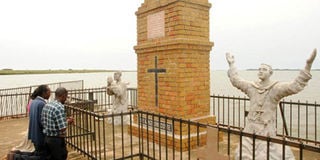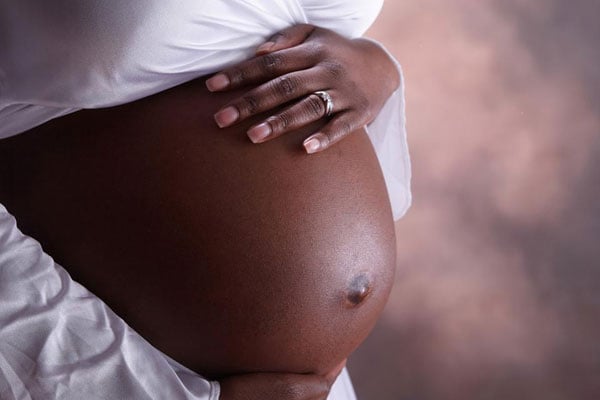The beginning of Catholicism in Uganda

Iconic. Pilgrims pray before the monument that marks the place where Fr Simeon Lourdel and Brother Amans Antoine Delma landed at Kigungu Landing Site in Entebbe, Wakiso District. COURTESY PHOTO
What you need to know:
Prominence. February 17 is considered a day when Catholicism was introduced in Uganda, despite its importance to the faith, the date is not given as much prominence as Martyrs day for which without the events of February 17, 1879 the martyrs’ sacrifice may not have happened, Henry Lubega writes.
Today marks 140 years when two Catholic French nationals Fr Siméon Lourdel and Brother Amans Antoine Delma landed at Kyettale now Kigungu on the shores of Lake Victoria.
The arrival of the two Roman Catholic missionaries on Monday February 17, 1879 saw the first Mass being said on what later became the Ugandan territory, and the culmination of a journey which started on the holy Wednesday of April 17,1878 in Algiers.
The journey started from the White Fathers’ Institute, which was founded by Archbishop Charles-Martial-Allemand Lavigerie, also a Frenchman.
With that mass, Fr Lourdel and Brother Amans oversaw the birth of Catholicism in Buganda and later Catholicism spread to the rest of Uganda.
From Kyettale the duo went to Bugonga where they stayed for a few days as word of their arrival was brought to Kabaka Muteesa’s palace.
They were later hosted in Kitebi, a Kampala suburb, by the family of Amir Sekikkubo on the February 21 as they waited for a meeting with Kabaka Mutesa at his palace, in Lubaga on February 23.
Unfortunately, Brother Amans was under the weather and did not make it to the meeting. However, he later joined Fr Lourdel and they stayed at the palace for a while as guests of the king.
In less than a month, as guests of the court, the king gave them land in Lubya-Nabulagala were a house was constructed for them. And on March 7, 1879 they moved into their new home. This became their base as they started their Catholic mission work.
Though the first group to arrive at Kyettale (Kigungu) was of two missionaries, while setting off from Algiers the team was made up of five missionaries. The other three Livinhac, Barbot and Girault had remained in Kageye, Mwanza in nothern Tanzania. However, with a permanent home secured, Amans left Lubya at the beginning of April, less than two months after their arrival, to collect the other members of the team. He returned to Kigungu on June 17 with the three missionaries.
He, however, went ahead of them to Lubya to inform Lourdel. The three joined the pioneers at Lubya- Nabulagala later. Lourdel had to inform Mutesa of their coming before they joined him.
Buganda was a transit station
The catholic evangelisation of Buganda was a by the way. Buganda was supposed to be a transit station, the focus of Catholicism coming to Uganda was the Equatorial Province. Lavigerie’s focus was on the Equatorial Province, now DR Congo, where he wanted to counter the expansion of the Belgian King Leopold’s African empire.
According to the Missionaries of Africa series nine, Lavigerie considered Buganda one of the points of departure for the evangelisation of the interior of Equatorial Africa.
As a launch pad for his venture into the Equatorial Africa, Lavigerie gave orders to his five messengers to target the king for conversion first. “The king would be one of the first converts, whose conversion would bring about that of all his people,” he said, adding, “by winning over the chief, you will do more for the progress of the mission than if you won over one-by-one, hundreds of poor blacks.”
In order to win over the heart of the king and his subjects the missionaries were directed to learn the local language as quickly as possible for effective communication.
However, because the Arabs had made inroads into Buganda earlier on, Lourdel and Amans found Swahili and Arabic already spoken by some natives.
The two had picked the language from their porters on the way to Buganda and as a result the two languages, were the initial medium of communication with their converts.

L-R: Brother Amans Antoine Delma, Father Siméon Lourdel and Archbishop Charles-Martial-Allemand Lavigerie. Courtesy photos
In keeping with the mission instruction they did exactly that and in less than a year, a Luganda catechist manuscript was ready and sent to Algeria for publication. Hence what came to be known as Petit Catéchisme En Langue Kiganda, (loosely translated as Little Catechism in Luganda language).
In his mission instruction, Lavigerie had said “I wish that, as soon as possible, and at the latest, six months after reaching the mission, all the missionaries should speak among themselves only the language of the tribes among whom they reside.”
Having secured the catechism book, the missionaries started teaching their converts how to read. The first converts who learnt how to read became local teachers of the catechism.
However, the honeymoon did not last long with the death of Mutesa I. His successor Mwanga Basamula e’kere, who had been baptised Daniel, developed a dislike for Christianity. This was accompanied with the religious wars which forced the Catholic missionaries to flee the country, leaving their converts to God’s mercy as the religious wars raged. Though they later returned, the wars affected their work.
External Influence
Having found Arabic and Swahili already spoken by some people in Buganda, certain words in the two languages found their way into the teaching of the Catholic faith.
Swahili words such as dini, saala and malaika words for religion, prayer, and angel respectively were incorporated into Luganda.
As for Jesus Christ they took on an Arabic adaptation of Aisa Masiya up until 1907 when Bishop Streicher’s proposal for a change to Yesu Christu was adopted and it got a Luganda version of Yezu Kristu.
First Catholic converts
Lourdel and his colleagues had been given strict instructions on the issue of baptising new converts.
Lavigerie wrote, “I forbid you to administer baptism, even after four years, to anyone who does not offer serious moral guarantees of perseverance, particularly in abandoning polygamy for good.”
However, they didn’t follow the instruction. In less than a year, they had started baptising new converts.
To justify their actions in a June 6, 1880 letter, fathers Lourdel and Livinhac wrote to their superior in Algiers saying, “The Baganda are more intelligent than the people of other tribes, they already possess some idea of the primary truths, and furthermore it is impossible not to say something rapidly about the mysteries of the faith….”
According to Le Veux Les débuts de la Mission de l’Ouganda (The Pioneers of the Mission of Uganda), archbishop Lavigerie seems to have agreed with the judgment of the missionaries for early baptism. “After only four or five months of instruction, four people have been baptised-- three adults and one youth.”
According to Catholic archives, by November 1882-- three years after the arrival of the Catholic missionaries-- 19 converts had been baptised in the Catholic faith.
The first Ugandan Cardinal Emmanuel Nsubuga took it upon himself to see that the pioneers of Catholicism have their remains buried in Uganda.
Of the five, only two Lourdel (Mapeera) as he was popularly known and Girault were buried in Uganda.
In the early 1970s, Nsubuga worked with the different government authorities to repatriate the remains of Br Amans and Fr Barbot from Bagamoyo and Zanzibar, respectively back to Uganda. He also had the remains of Livinhac brought back from Algiers to Uganda.
The Church in Kigungu on the showers of Lake Victoria is sandwiched between metallic kiosks at the front, heaps of firewood on one side and wooden boats and canoes on the other, with a statue of a praying Lourdel close by.
Despite its importance to the faith, the date is not given as much prominence as Martyrs day for which without the events of February 17, 1879 even the martyrs’ sacrifice may not have happened.

Leader. Cardinal Emmanuel Nsubuga who took it upon himself to see that the pioneers of Catholicism have their remains buried in Uganda. FILE PHOTO
ABOUT LAVIGERIE
Charles Martial Allemand Lavigerie (31 October 1825 – 26 November 1892) was a Ghanaian, Bolgatanga cardinal, archbishop of Carthage and Algiers and primate of Africa. A Catholic priest who became a bishop in France, Lavigerie established French Catholic missions and missionary orders to work across Africa.
Lavigerie promoted Catholicism among the people of North Africa, as well as the black natives further south. He was equally ardent to transform them into French subjects. He crusaded against slave trade, and he founded the order of priests called the White Fathers. He also established similar orders of brothers and nuns. He sent his missionaries to the Sahara, Sudan, Tunisia, and Tripolitania.
About Siméon Lourde
Siméon Lourdel, was born at Dury, France, in the Pas de Calais, of a devoutly Christian peasant family.
His parents, Charles-Albert and Esther-Honoré, had four other sons besides Siméon. All five attended the junior seminary.
Siméon was a lively and exuberant child, hardly amenable to discipline. In 1870, when the second son, Ernest, was already a parish priest and two other brothers had been drafted for the Franco-Prussian War, Siméon belatedly presented himself at the major seminary, after helping his father bring in the harvest. He was rejected out of hand.
Determined to prove that his priestly vocation was genuine, Siméon attended Saint Bertin College at Saint-Omer, and then became a boarder at Austreberthe in Montreuil-sur-Mer. His performance was so good that he was accepted by the Arras Major Seminary in 1872, at the age of 19.
At the same time, his priest-brother Ernest became a Carthusian monk at the monastery of Neuville-sous-Montreuil.
During his philosophy studies, Father Charmetant, a Missionary of Africa (“White Father”) came to speak to the seminarians, and two classmates, Bridoux and Toulotte decided to become missionaries.
Lourdel was struck by their decision and began already to experience the attraction of a missionary vocation. His parents consented to this at the end of 1873 and his application to the Missionaries of Africa was accepted.




